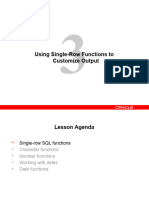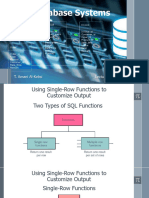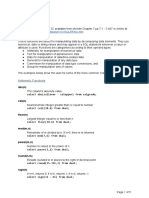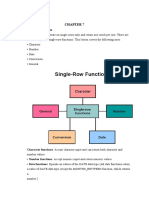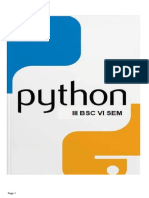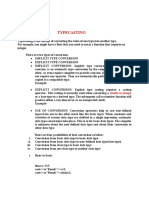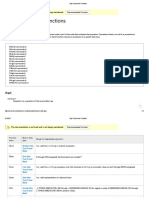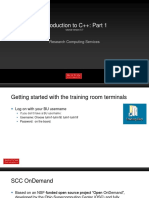Database Management
Systems
Subject Teacher: Zartasha Baloch
2
Single Row Functions
Lecture # 14 & 15
Disclaimer: The material used in this presentation to deliver the lecture i.e., definitions/text and
pictures/graphs etc. does not solely belong to the author/presenter. The presenter has gathered this
lecture material from various sources on web/textbooks. Following sources are especially
acknowledged:
1. Connolly, Thomas M., and Carolyn E. Begg. Database systems: a practical approach to design, implementation,
and management. Pearson Education, 2005.
2. Gorman, Tim, Inger Jorgensen, Melanie Caffrey, and Lex deHaan. Beginning Oracle SQL: For Oracle Database
12c. Apress, 2014.
3. Greenberg, Nancy, and Instructor Guide PriyaNathan. "Introduction to Oracle9i: SQL." ORACLE, USA (2001).
Objectives
After completing this lesson, you should be able to do the following:
Describe various types of functions available
in SQL
Use character, number, and date functions in SELECT statements
Describe the use of conversion functions
SQL Functions
Input Output
Function
arg 1 Function
performs action
arg 2
Result
value
arg n
Two Types of SQL Functions
Functions
Single-row Multiple-row
functions functions
Single-Row Functions
Single row functions:
Manipulate data items
Accept arguments and return one value
Act on each row returned
Return one result per row
May modify the data type
Can be nested
Accept arguments which can be a column or an expression
function_name [(arg1, arg2,...)]
Single-Row Functions
Character
General Number
Single-row
functions
Conversion Date
Character Functions
Character
functions
Case-manipulation Character-manipulation
functions functions
LOWER CONCAT
UPPER SUBSTR
INITCAP LENGTH
INSTR
LPAD | RPAD
TRIM
REPLACE
Case Manipulation Functions
These functions convert case for character strings.
Function Result
LOWER('SQL Course') sql course
UPPER('SQL Course') SQL COURSE
INITCAP('SQL Course') Sql Course
Using Case Manipulation Functions
Display the employee number, name, and department number
for employee Higgins:
SELECT empno, ename, deptno
FROM emp
WHERE ename = 'higgins';
no rows selected
SELECT empno, ename, deptno
FROM emp
WHERE LOWER(ename) = 'higgins';
Character-Manipulation Functions
These functions manipulate character strings:
Function Result
CONCAT('Hello', 'World') HelloWorld
SUBSTR('HelloWorld’,-3,3) Hello
LENGTH('HelloWorld') 10
INSTR('HelloWorld’, ‘W') 6
LPAD(salary,10,'*') *****24000
RPAD(salary, 10, '*') 24000*****
TRIM('H' FROM 'HelloWorld') elloWorld
Using the Character-Manipulation
Functions
1
SELECT employee_id, CONCAT(first_name, last_name) NAME,
job_id, LENGTH (last_name), 2
INSTR(last_name, 'a') "Contains 'a'?"
FROM employees 3
WHERE SUBSTR(job_id, 4) = 'REP';
1 2 3
Number Functions
ROUND: Rounds value to specified decimal
ROUND(45.926, 2) 45.93
TRUNC: Truncates value to specified decimal
TRUNC(45.926, 2) 45.92
MOD: Returns remainder of division
MOD(1600, 300) 100
Using the ROUND Function
1 2
SELECT ROUND(45.923,2), ROUND(45.923,0),
ROUND(45.923,-1) 3
FROM DUAL;
1 2 3
DUAL is a dummy table you can use to view results
from functions and calculations.
Using the TRUNC Function
1 2
SELECT TRUNC(45.923,2), TRUNC(45.923),
TRUNC(45.923,-2) 3
FROM DUAL;
1 2 3
Using the MOD Function
Calculate the remainder of a salary after it is divided by 5000 for
all employees whose job title is sales representative.
SELECT last_name, salary, MOD(salary, 5000)
FROM employees
WHERE job_id = 'SA_REP';
Working with Dates
Oracle database stores dates in an internal numeric format: century, year, month, day,
hours, minutes, seconds.
The default date display format is DD-MON-RR.
Allows you to store 21st century dates in the 20th century by specifying only the last two digits of
the year.
Allows you to store 20th century dates in the 21st century in the same way.
SELECT last_name, hire_date
FROM employees
WHERE last_name like 'G%';
Working with Dates
SYSDATE is a function that returns:
Date
Time
Arithmetic with Dates
Add or subtract a number to or from a date for a resultant date value.
Subtract two dates to find the number of days between those dates.
Add hours to a date by dividing the number of hours by 24.
Using Arithmetic Operators
with Dates
SELECT last_name, (SYSDATE-hire_date)/7 AS WEEKS
FROM employees
WHERE department_id = 90;
Date Functions
Function Description
MONTHS_BETWEEN Number of months
between two dates
ADD_MONTHS Add calendar months to
date
NEXT_DAY Next day of the date
specified
LAST_DAY Last day of the month
ROUND Round date
TRUNC Truncate date
Using Date Functions
• MONTHS_BETWEEN ('01-SEP-95','11-JAN-94')
19.6774194
• ADD_MONTHS ('11-JAN-94',6) '11-JUL-94'
• NEXT_DAY ('01-SEP-95','FRIDAY')
'08-SEP-95'
• LAST_DAY('01-FEB-95') '28-FEB-95'
Using Date Functions
Assume SYSDATE = '25-JUL-95':
• ROUND(SYSDATE,'MONTH') 01-AUG-95
• ROUND(SYSDATE ,'YEAR') 01-JAN-96
• TRUNC(SYSDATE ,'MONTH') 01-JUL-95
• TRUNC(SYSDATE ,'YEAR') 01-JAN-95
Practice, Part One: Overview
This practice covers the following topics:
Writing a query that displays the current date
Creating queries that require the use of numeric, character, and date functions
Performing calculations of years and months of service for an employee
Conversion Functions
Data type
conversion
Implicit data type Explicit data type
conversion conversion
Implicit Data Type Conversion
For assignments, the Oracle server can automatically convert the following:
From To
VARCHAR2 or CHAR NUMBER
VARCHAR2 or CHAR DATE
NUMBER VARCHAR2
DATE VARCHAR2
Implicit Data Type Conversion
For expression evaluation, the Oracle Server can automatically convert the following:
From To
VARCHAR2 or CHAR NUMBER
VARCHAR2 or CHAR DATE
Explicit Data Type Conversion
TO_NUMBER TO_DATE
NUMBER CHARACTER DATE
TO_CHAR TO_CHAR
Using the TO_CHAR Function with Dates
TO_CHAR(date, 'format_model')
The format model:
Must be enclosed in single quotation marks and is case sensitive
Can include any valid date format element
Has an fm element to remove padded blanks or suppress leading
zeros
Is separated from the date value by a comma
Elements of the Date Format Model
YYYY Full year in numbers
YEAR Year spelled out
MM Two-digit value for month
MONTH Full name of the month
Three-letter abbreviation of the
MON
month
Three-letter abbreviation of the
DY
day of the week
DAY Full name of the day of the week
DD Numeric day of the month
Elements of the Date Format Model
Time elements format the time portion of the date.
HH24:MI:SS AM 15:45:32 PM
Add character strings by enclosing them in double quotation marks.
DD "of" MONTH 12 of OCTOBER
Number suffixes spell out numbers.
ddspth fourteenth
Using the TO_CHAR Function with Dates
SELECT last_name,
TO_CHAR(hire_date, 'fmDD Month YYYY')
AS HIREDATE
FROM employees;
…
Using the TO_CHAR Function with Numbers
TO_CHAR(number, 'format_model')
These are some of the format elements you can use with the
TO_CHAR function to display a number value as a character:
9 Represents a number
0 Forces a zero to be displayed
$ Places a floating dollar sign
L Uses the floating local currency symbol
. Prints a decimal point
, Prints a thousand indicator
Using the TO_CHAR Function with Numbers
SELECT TO_CHAR(salary, '$99,999.00') SALARY
FROM employees
WHERE last_name = 'Ernst';
Using the TO_NUMBER and TO_DATE Functions
Convert a character string to a number format using the TO_NUMBER
function:
TO_NUMBER(char[, 'format_model'])
Convert a character string to a date format using the TO_DATE function:
TO_DATE(char[, 'format_model'])
These functions have fx modifier. This modifier specifies the exact
matching for the character argument and date format model of a
TO_DATE function
RR Date Format
Current Year Specified Date RR Format YY Format
1995 27-OCT-95 1995 1995
1995 27-OCT-17 2017 1917
2001 27-OCT-17 2017 2017
2001 27-OCT-95 1995 2095
If the specified two-digit year is:
0–49 50–99
If two digits The return date is in The return date is in
of the 0–49 the current century the century before
current the current one
year are: The return date is in The return date is in
50–99 the century after the current century
the current one
37
MySQL Format
Syntax STR_TO_DATE(string, format)
Quick Example SELECT STR_TO_DATE('17-09-2010','%d-%m-%Y');
Error Returns NULL if the format is not matched, or datetime value is not valid
MySQL Oracle Format Specifier
%Y YYYY 4-digit year
%y YY 2-digit year
Abbreviated month (Jan
%b MON
- Dec)
Month name (January -
%M MONTH
December)
%m MM Month (1 - 12)
Abbreviated day (Sun -
%a DY
Sat)
%d DD Day (1 - 31)
%H HH24 Hour (0 - 23)
%h HH or HH12 Hour (1 - 12)
%i MI Minutes (0 - 59)
%s SS Seconds (0 - 59)
Example of RR Date Format
To find employees hired prior to 1990, use the RR format, which produces
the same results whether the command is run in 1999 or now:
SELECT last_name, TO_CHAR(hire_date, 'DD-Mon-YYYY')
FROM employees
WHERE hire_date < TO_DATE('01-Jan-90', 'DD-Mon-RR');
Nesting Functions
Single-row functions can be nested to any level.
Nested functions are evaluated from deepest level to the
least deep level.
F3(F2(F1(col,arg1),arg2),arg3)
Step 1 = Result 1
Step 2 = Result 2
Step 3 = Result 3
Nesting Functions
SELECT last_name,
NVL(TO_CHAR(manager_id), 'No Manager')
FROM employees
WHERE manager_id IS NULL;
General Functions
These functions work with any data type and pertain
to using nulls.
NVL (expr1, expr2)
NVL2 (expr1, expr2, expr3)
NULLIF (expr1, expr2)
COALESCE (expr1, expr2, ..., exprn)
NVL Function
Converts a null to an actual value.
Data types that can be used are date, character, and
number.
Data types must match:
NVL(commission_pct,0)
NVL(hire_date,'01-JAN-97')
NVL(job_id,'No Job Yet')
Using the NVL Function
SELECT last_name, salary, NVL(commission_pct, 0), 1
(salary*12) + (salary*12*NVL(commission_pct, 0)) AN_SAL 2
FROM employees;
1 2
Using the NVL2 Function
SELECT last_name, salary, commission_pct, 1
NVL2(commission_pct,
'SAL+COMM', 'SAL') income
2
FROM employees WHERE department_id IN (50, 80);
1 2
Using the NULLIF Function
1
SELECT first_name, LENGTH(first_name) "expr1",
last_name, LENGTH(last_name) "expr2", 2
NULLIF(LENGTH(first_name), LENGTH(last_name)) result 3
FROM employees;
1 2 3
Using the COALESCE Function
The advantage of the COALESCE function over the NVL function is that the COALESCE
function can take multiple alternate values.
If the first expression is not null, it returns that expression; otherwise, it does a COALESCE
of the remaining expressions.
Using the COALESCE Function
SELECT last_name,
COALESCE(commission_pct, salary, 10) comm
FROM employees
ORDER BY commission_pct;
…
Conditional Expressions
Provide the use of IF-THEN-ELSE logic within a SQL statement
Use two methods:
CASE expression
DECODE function
The CASE Expression
Facilitates conditional inquiries by doing the work of an IF-THEN-ELSE
statement:
CASE expr WHEN comparison_expr1 THEN return_expr1
[WHEN comparison_expr2 THEN return_expr2
WHEN comparison_exprn THEN return_exprn
ELSE else_expr]
END
Using the CASE Expression
Facilitates conditional inquiries by doing the work of an IF-THEN-ELSE statement:
SELECT last_name, job_id, salary,
CASE job_id WHEN 'IT_PROG' THEN 1.10*salary
WHEN 'ST_CLERK' THEN 1.15*salary
WHEN 'SA_REP' THEN 1.20*salary
ELSE salary END "REVISED_SALARY"
FROM employees;
…
The DECODE Function
Facilitates conditional inquiries by doing the work of a CASE or IF-THEN-ELSE
statement:
DECODE(col|expression, search1, result1
[, search2, result2,...,]
[, default])
Using the DECODE Function
SELECT last_name, job_id, salary,
DECODE(job_id, 'IT_PROG', 1.10*salary,
'ST_CLERK', 1.15*salary,
'SA_REP', 1.20*salary,
salary)
REVISED_SALARY
FROM employees;
…
Using the DECODE Function
Display the applicable tax rate for each employee in
department 80.
SELECT last_name, salary,
DECODE (TRUNC(salary/2000, 0),
0, 0.00,
1, 0.09,
2, 0.20,
3, 0.30,
4, 0.40,
5, 0.42,
6, 0.44,
0.45) TAX_RATE
FROM employees
WHERE department_id = 80;
Summary
In this lesson, you should have learned how to:
Perform calculations on data using functions
Modify individual data items using functions
Manipulate output for groups of rows using functions
Alter date formats for display using functions
Convert column data types using functions
Use NVL functions
Use IF-THEN-ELSE logic





















